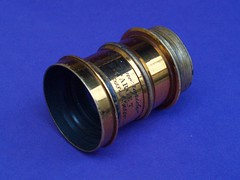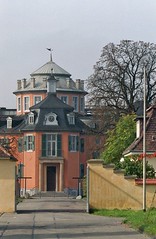Difference between revisions of "Rapid Rectilinear"
(Remove incomprehensible sentence.) |
|||
| Line 11: | Line 11: | ||
| image_text=Rectiligne rapide | | image_text=Rectiligne rapide | ||
}} | }} | ||
| + | |||
A '''Rapid Rectilinear''' [[lens]], or '''RR lens''', is made of a symmetrical pair of cemented doublets. It was introduced by [[Dallmeyer]] in 1866. At the same time [[Steinheil]] invented a similar construction, the '''Aplanat''' lens. It's a pair of achromatic lens element groups, arranged symmetrically before and behind the [[diaphragm]]. The outer lens elements of the two lens groups are concave [[meniscus lens]] elements, the inner lens elements are convex meniscus lens elements, made of another glass sort. This lens construction reduces effectively radial distortion. Dallmeyer's original '''Rectilinear''' wide angle lense's rear lens group is smaller in diameter than the front lens group. The Rapid Rectilinear has two equal sized lens goups, as well as the Aplanat's. Steinheil offered a landscape Aplanat, a portrait Aplanat and a wide angle Aplanat. | A '''Rapid Rectilinear''' [[lens]], or '''RR lens''', is made of a symmetrical pair of cemented doublets. It was introduced by [[Dallmeyer]] in 1866. At the same time [[Steinheil]] invented a similar construction, the '''Aplanat''' lens. It's a pair of achromatic lens element groups, arranged symmetrically before and behind the [[diaphragm]]. The outer lens elements of the two lens groups are concave [[meniscus lens]] elements, the inner lens elements are convex meniscus lens elements, made of another glass sort. This lens construction reduces effectively radial distortion. Dallmeyer's original '''Rectilinear''' wide angle lense's rear lens group is smaller in diameter than the front lens group. The Rapid Rectilinear has two equal sized lens goups, as well as the Aplanat's. Steinheil offered a landscape Aplanat, a portrait Aplanat and a wide angle Aplanat. | ||
| + | |||
| + | {{Flickr image | ||
| + | | image_source=http://s916.photobucket.com/albums/ad6/tamasflexoptics/Petzval/Dagor/Aplanat/?action=view¤t=aplanat.png | ||
| + | | image=http://i916.photobucket.com/albums/ad6/tamasflexoptics/Petzval/Dagor/Aplanat/th_aplanat.png | ||
| + | | image_align=right | ||
| + | | image_text=Extra Rapid Aplanat | ||
| + | }} | ||
| + | |||
| + | |||
| + | |||
| + | |||
| + | |||
| + | |||
| + | |||
| + | |||
| + | |||
{{br}} | {{br}} | ||
'''Imaging samples''' | '''Imaging samples''' | ||
Revision as of 19:55, 15 July 2009

|
| a French "Extra Rapid Rectilinear" |

|
| Rectiligne rapide |
A Rapid Rectilinear lens, or RR lens, is made of a symmetrical pair of cemented doublets. It was introduced by Dallmeyer in 1866. At the same time Steinheil invented a similar construction, the Aplanat lens. It's a pair of achromatic lens element groups, arranged symmetrically before and behind the diaphragm. The outer lens elements of the two lens groups are concave meniscus lens elements, the inner lens elements are convex meniscus lens elements, made of another glass sort. This lens construction reduces effectively radial distortion. Dallmeyer's original Rectilinear wide angle lense's rear lens group is smaller in diameter than the front lens group. The Rapid Rectilinear has two equal sized lens goups, as well as the Aplanat's. Steinheil offered a landscape Aplanat, a portrait Aplanat and a wide angle Aplanat.
| http://i916.photobucket.com/albums/ad6/tamasflexoptics/Petzval/Dagor/Aplanat/th_aplanat.png |
| Extra Rapid Aplanat |
Imaging samples

|
| Aplanat and wide angle Aplanat |

|

|

|
made with a Rectilineaire Extra Rapide on an Antique Camera Simulator